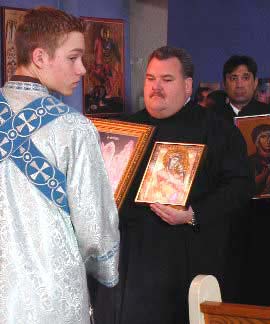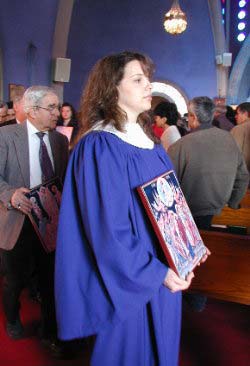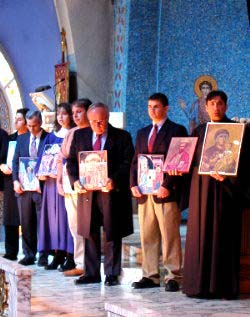|
|
|
Two Byzantine Women
Two women played a major role in ending iconoclasm. In the late eighth century, the mother of then-emperor Constantine VI, Irene, deposed and blinded her son. She became the first woman to rule Byzantium in her own right. Devoutly religious, the empress Irene put an end to persecutions of those who used icons. Today, she is venerated as an Orthodox saint.
But her reign was short, and a second wave of iconoclasm began after she was deposed and sent into exile. Although the Second Nicaean Council (787) had rejected the movement against icons, making a distinction between veneration and idolatrous worship, persecutions continued into the ninth century.
|
 |
|
|
Through the influence of another powerful Byzantine woman -- Theodora, who acted as regent for her son, the child emperor Michael -- the iconoclasts were finally defeated. Secretly supportive of icons during the purges led by her husband, she used her newly-gained power to remove clergy installed under the old regime and replace them with monks who had withstood persecution. In 842, icons were restored to Byzantine churches in a ceremony which is re-enacted every year during Lent.
Commemorating A Hard Time
"We commemorate a hard time, a bad time of the Church when some fanatic clergy thought we were actually worshipping idols through the icons," said Fr. Michael Kouremetis of the St. George Cathedral in Manchester. "They destroyed the icons, ripped them out of the churches, and wouldn't allow them in worship. They were restored through the ecumenical council and presented back into the church in its proper and right order, as an instrument of reverencing, not of worship."
|
 |
|
|
|
Each year on the second Sunday of Lent, St. George's parishioners carry icons in a solemn procession through the aisles of the cathedral, then stand facing the congregation in a ceremony memorializing the restoration of the icons in 842. The ceremony "makes us understand how important the church is, and how icons in our worship are so important as we journey through Lent," Fr. Kouremetis said. Traditionally, the Sunday of Orthodoxy is an occasion when churches emphasize the universality of the faith and the overcoming of ethnic and national differences. The Second Nicaean Council, which restored the icons, preceded the schism between the Eastern and Western church, and is the last ecumenical council recognized by both.
|
 |
|
|
|
|
|
St. George's Greek Orthodox Cathedral, Manchester, New Hampshire (Photos by Hellenic Communication Service) |
|
|
|
|
|
|
|
|
|
|



